Fundação Darcy Vargas participa de workshop sobre Mobilização de Recursos para o Dia de Doar
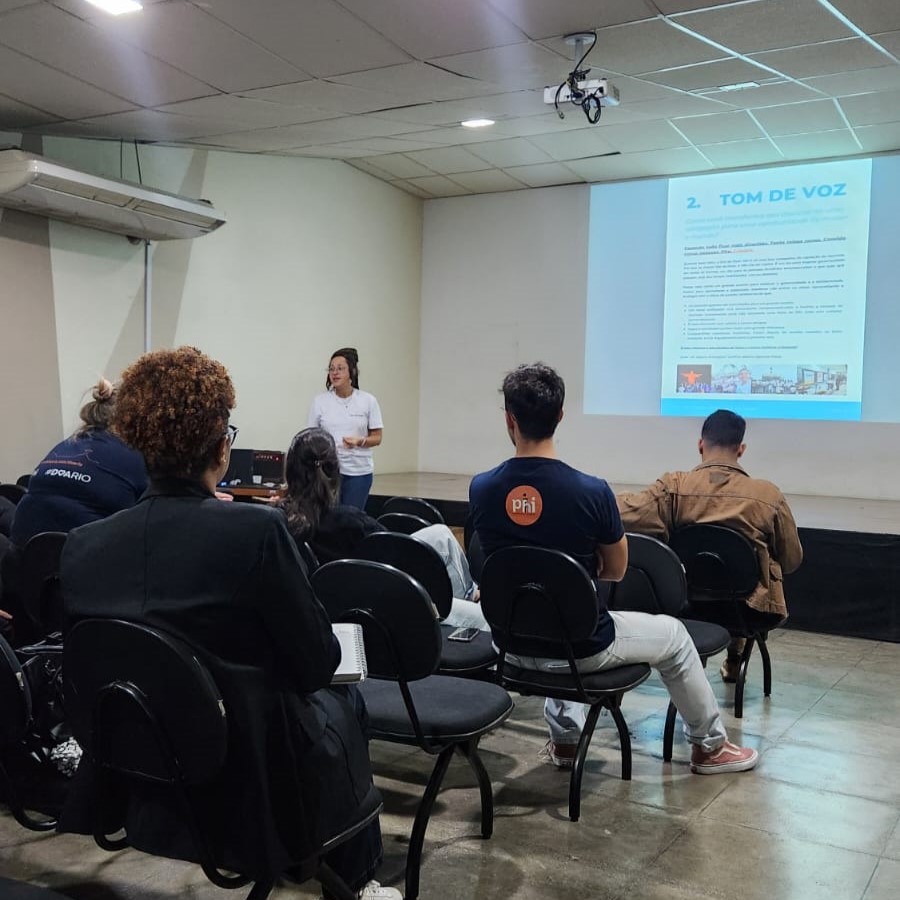
A Fundação Darcy Vargas recebeu o Workshop de Mobilização de Recursos para o Dia de Doar, um evento de grande relevância para o terceiro setor. Promovido pela Associação Brasileira de Captadores de Recursos (ABCR), com o apoio da Fundação José Luiz Egydio Setúbal e do Movimento por uma Cultura de Doação, o evento no Rio de Janeiro contou também com a colaboração do Instituto Phi. O workshop, liderado por Carol Farias, responsável pelo Dia De Doar, abordou estratégias essenciais para campanhas de arrecadação, comunicação de impacto e formação de parcerias. A iniciativa busca fortalecer as ações e ampliar o impacto social do Dia de Doar, promovendo a construção de uma rede de doação sólida no Brasil. O Dia de Doar é um movimento que visa promover a generosidade e a cultura de doação, incentivando a construção de um país mais doador e empático por meio da conexão de pessoas. Esse movimento celebra o prazer de doar e impulsiona o hábito de doar continuamente. A Fundação Darcy Vargas, como organização sem fins lucrativos, apoia o Dia de Doar porque depende do apoio de pessoas e empresas para alavancar projetos que garantam uma educação de qualidade para mais de 175 jovens em situação de vulnerabilidade, mantendo taxas de evasão escolar em zero. Estamos analisando a oportunidade de participar do movimento Dia de Doar, que acontece no dia 3 de dezembro de 2024, para potencializar ainda mais a captação de recursos e garantir a continuidade de nossas atividades essenciais. A participação nesse movimento é vital para a continuidade e expansão do trabalho social da Fundação, reafirmando a importância de unir esforços em prol de causas sociais no país.
Fundação Darcy Vargas recebe visita da Turma do Bem
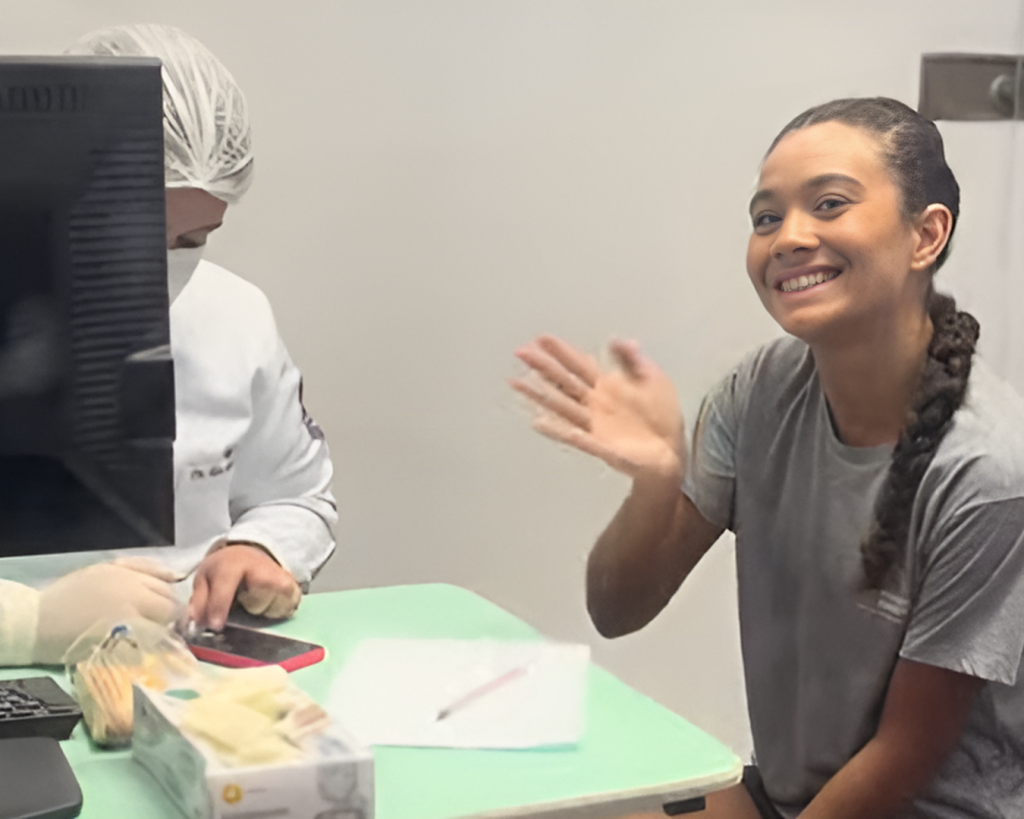
Na última quinta-feira, 22 de agosto, a Fundação Darcy Vargas recebeu a visita da Turma do Bem (TdB). A ação teve como objetivo realizar a triagem odontológica dos alunos, para que possam ser encaminhados aos dentistas voluntários do projeto, garantindo-lhes atendimento odontológico gratuito. A Turma do Bem é uma organização reconhecida por gerenciar a maior rede de voluntariado especializado do mundo, contando com a atuação de mais de 18 mil dentistas em 12 países. De um a um, cerca de 60 dos nossos alunos foram atendidos pela dentista voluntária que examinou cada caso a ser atendido pelas clínicas odontológicas cadastradas no projeto. A visita da TdB à Fundação Darcy Vargas reforça o compromisso em oferecer suporte e melhores condições de vida para as populações mais vulneráveis. O trabalho conjunto promete trazer resultados significativos, especialmente na transformação da percepção social sobre a importância da saúde bucal e seu impacto no bem-estar geral das pessoas. Essa parceria é mais um passo importante na nossa missão de proporcionar um futuro mais digno e saudável para aqueles que mais precisam.
World Environment Day: A Global Call to Action for Our Planet
Every year on June 5th, the world unites for a singular, urgent purpose: to celebrate and protect our shared home. This is World Environment Day, the United Nations’ principal vehicle for encouraging worldwide awareness and action for the environment. Far more than just a date on the calendar, it has evolved into the largest global platform for environmental public outreach, a day when millions of people, governments, and corporations come together to focus on the planet’s most pressing challenges and champion its preservation. The genesis of World Environment Day dates back to 1972, a landmark year for global environmental consciousness. The United Nations Conference on the Human Environment in Stockholm, Sweden, held from June 5-16, was the first major international summit to place environmental issues at the forefront of global concerns. Later that year, on December 15, the UN General Assembly adopted a resolution designating June 5 as World Environment Day, marking the conference’s opening day. The very first World Environment Day was celebrated one year later, in 1973, with the fitting slogan, “Only One Earth,” a simple yet profound message that continues to resonate five decades later. A central pillar of the day’s effectiveness is its annual, thematic focus. Each year, the UN designates a specific theme to highlight a particularly critical environmental issue. This strategy concentrates the global conversation, forcing the world to collectively examine a single problem, understand its complexities, and explore tangible solutions. These themes are a mirror of our planet’s evolving crises. Recent years, for example, have seen campaigns like #BeatPlasticPollution, a powerful call to action against one of the most visible and pervasive forms of pollution devastating our oceans and ecosystems. Other themes have focused on biodiversity loss (“Time for Nature”), air pollution, and the urgent need for ecosystem restoration. In 2024, the global focus was directed toward “Land restoration, desertification, and drought resilience,” under the slogan “Our land. Our future. We are #GenerationRestoration.” This theme underscores the critical reality that healthy land is the foundation of our survival. With billions of hectares of land worldwide degraded, affecting billions of people, the call to action is to revive these ecosystems, combat the encroaching deserts, and build resilience against climate-driven droughts. To spearhead this global conversation, a different nation is designated as the official “host country” each year. This role is not merely ceremonial; the host nation serves as the epicenter for the year’s official celebrations, policy discussions, and high-level events. By hosting, a country showcases its own environmental challenges and achievements while leading a global dialogue on the year’s theme. For 2024, the Kingdom of Saudi Arabia hosted the official celebrations, bringing global attention to the unique and severe challenges of land degradation and desertification faced by arid regions around the world. The true power of World Environment Day, however, lies in its translation from a high-level concept into grassroots action. On June 5th, the globe comes alive with activity. In thousands of communities across more than 150 countries, individuals, schools, and local organizations participate in events tailored to their own environments. This can range from massive community clean-up drives along beaches and rivers to large-scale tree-planting initiatives aimed at restoring local forests. Education is a fundamental component of the day. Schools and universities dedicate curricula to the year’s theme, while museums and public institutions launch exhibits. Governments and NGOs run widespread public awareness campaigns, using the day as a potent hook to disseminate information on sustainable practices, such as recycling, water conservation, and reducing one’s carbon footprint. For many corporations, it is a day to announce new sustainability commitments, launch green products, or engage employees in corporate responsibility projects. Ultimately, World Environment Day serves as a critical annual checkpoint for humanity. It is a day to reflect on our relationship with the natural world, to acknowledge the damage inflicted, and, most importantly, to renew our collective and individual commitment to healing. It serves as a powerful reminder that the monumental challenges of climate change, pollution, and biodiversity loss are not insurmountable. They are the sum of billions of individual actions, and they can be solved by the power of billions of corrective, conscious, and collaborative ones. It galvanizes this collective energy, reminding us that we are all stakeholders in our planet’s future and that every action, no matter how small, contributes to the larger movement of change. Deneme Bonusu Veren Bahis Siteleri Deneme Bonusu Veren Bahis Siteleri Deneme Bonusu Veren Bahis Siteleri Deneme Bonusu Veren Bahis Siteleri Deneme Bonusu Veren Bahis Siteleri Deneme Bonusu Veren Bahis Siteleri Deneme Bonusu Veren Bahis Siteleri Deneme Bonusu Veren Bahis Siteleri Deneme Bonusu Veren Bahis Siteleri Deneme Bonusu Veren Bahis Siteleri Deneme Bonusu Veren Bahis Siteleri Deneme Bonusu Veren Bahis Siteleri Deneme Bonusu Veren Bahis Siteleri Deneme Bonusu Veren Bahis Siteleri Deneme Bonusu Veren Bahis Siteleri Deneme Bonusu Veren Bahis Siteleri Deneme Bonusu Veren Bahis Siteleri Deneme Bonusu Veren Bahis Siteleri
Visita de executivos da L’Oréal à Fundação Darcy Vargas destaca Iniciativa de Inclusão e Tecnologia
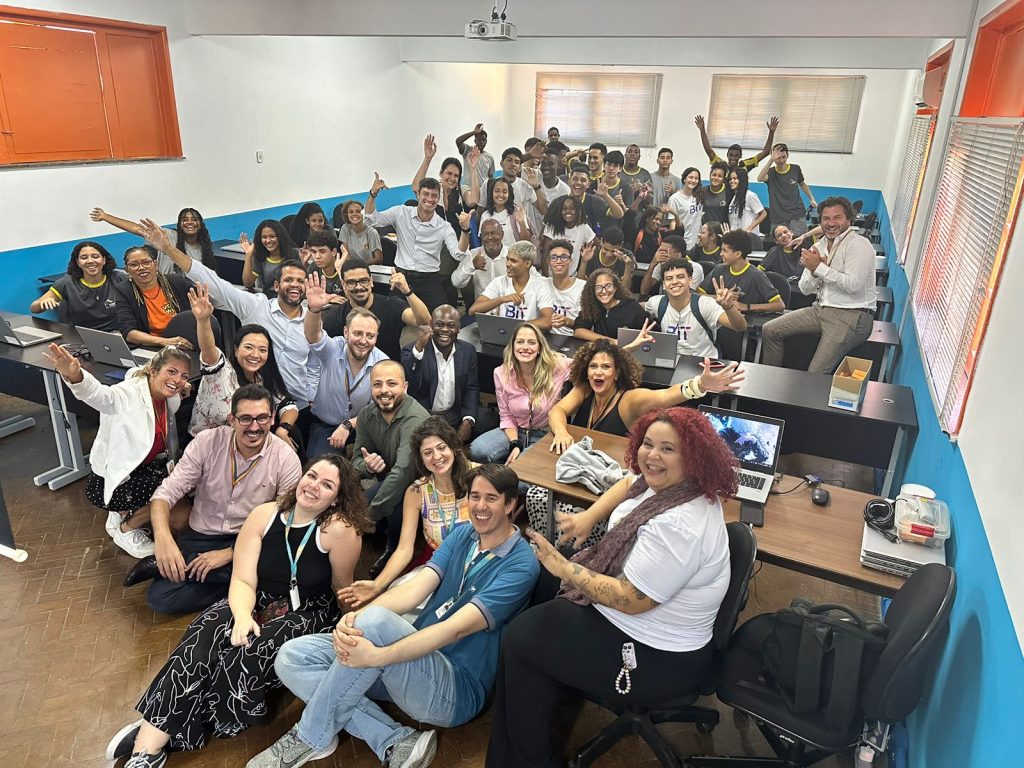
No dia 7 de agosto, a Fundação Darcy Vargas recebeu figuras de destaque do Grupo L’Oréal em uma visita que reforça o compromisso da empresa com a inclusão e a educação tecnológica. Jacob Bonk, responsável pelo RH das Américas, e Ope Bakare, Vice-Presidente de Integrações e Arquitetura das Américas, estiveram na instituição para conhecer de perto o projeto BIT – Beleza Inclusiva e Tecnológica, que oferece um curso de programação para 50 alunos da Fundação. Acompanhados por Helen Pedroso, Diretora de Responsabilidade Corporativa e Direitos Humanos da L’Oréal Brasil, e William Potenti, Diretor de Tecnologia e Informação da L’Oréal Brasil, os executivos tiveram a oportunidade de ver o programa em ação. Neste dia, os alunos estavam assistindo a uma aula sobre Inteligência Artificial, uma das várias habilidades digitais que o curso busca desenvolver. Durante a visita, Raonny Lopes, aluno do terceiro ano da Fundação Darcy Vargas, conversou com os visitantes e expressou sua gratidão pela oportunidade oferecida pelo programa. Ele destacou a importância do curso para sua carreira futura e enfatizou o carinho com que os professores da instituição trabalham: “Nesta escola, eles trabalham com amor”, afirmou. O programa BIT é fruto de uma parceria entre a L’Oréal, a Fundação Darcy Vargas, o Vai na Web e o Instituto Precisa Ser, e tem como objetivo preparar jovens para o mercado de trabalho, desenvolvendo competências digitais que são cada vez mais demandadas no mundo atual.
Arraiá da Fundação Darcy Vargas retorna após 6 anos e bate recorde de público
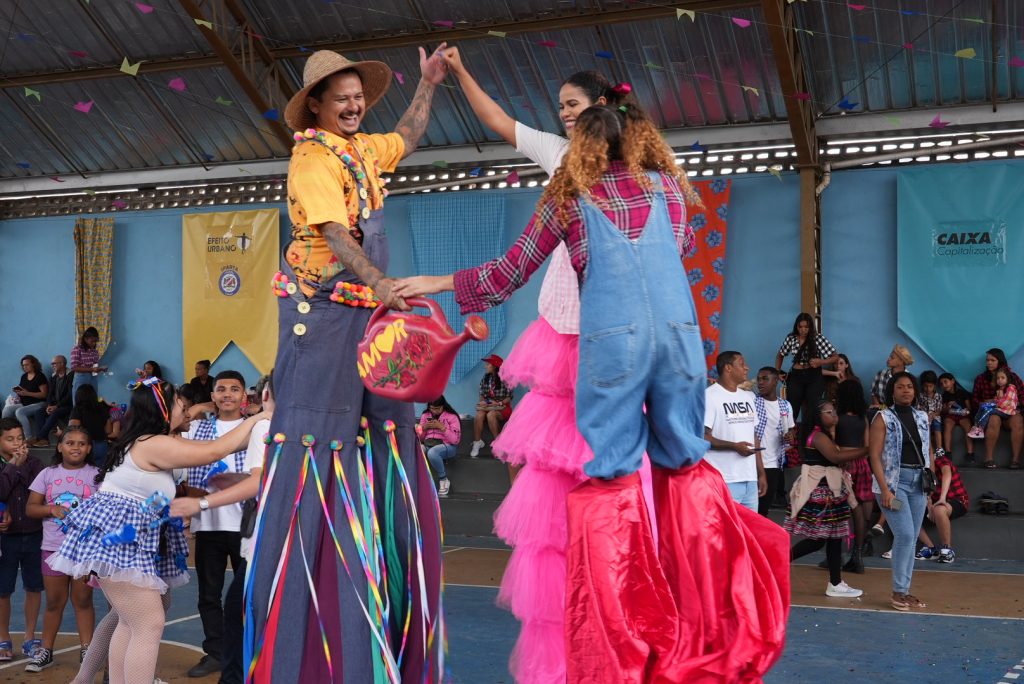
A tradicional festa da Casa do Pequeno Jornaleiro, promovida pela Fundação Darcy Vargas (FDV), na região da Pequena África, voltou com força total no dia 12 de julho, após seis anos. O evento, que superou as expectativas com a presença de mais de 900 pessoas, celebrou a cultura, a solidariedade e a união da comunidade. Com o lema “uma escola que transborda”, o Arraiá FDV abriu suas portas para a participação de oito organizações e projetos sociais, como a Casa Amarela, a Galeria da Providência e o Rio Memórias, beneficiando diretamente mais de 210 pessoas e, indiretamente, mais de 7.500. A iniciativa reforça o compromisso da FDV em fortalecer os laços comunitários e promover a visibilidade de projetos que impactam positivamente a sociedade. A renda arrecadada durante o evento será destinada à manutenção da escola da FDV, que desempenha um papel crucial na educação de quase 200 alunos do Ensino Fundamental II e Médio em situação de vulnerabilidade social. O apoio da Caixa Capitalização e da Cury Construtora foi fundamental para a realização do evento, demonstrando o poder da colaboração entre diferentes setores da sociedade. O Arraiá FDV não é apenas uma festa, mas um elo que conecta gerações e preserva a rica cultura brasileira. Danças, músicas e comidas típicas encheram o ambiente de alegria e união, proporcionando um dia inesquecível para todos os presentes. A Fundação Darcy Vargas reafirma seu compromisso em promover o espírito comunitário e a alegria através de eventos como o Arraiá.
Curso de capacitação em tecnologia
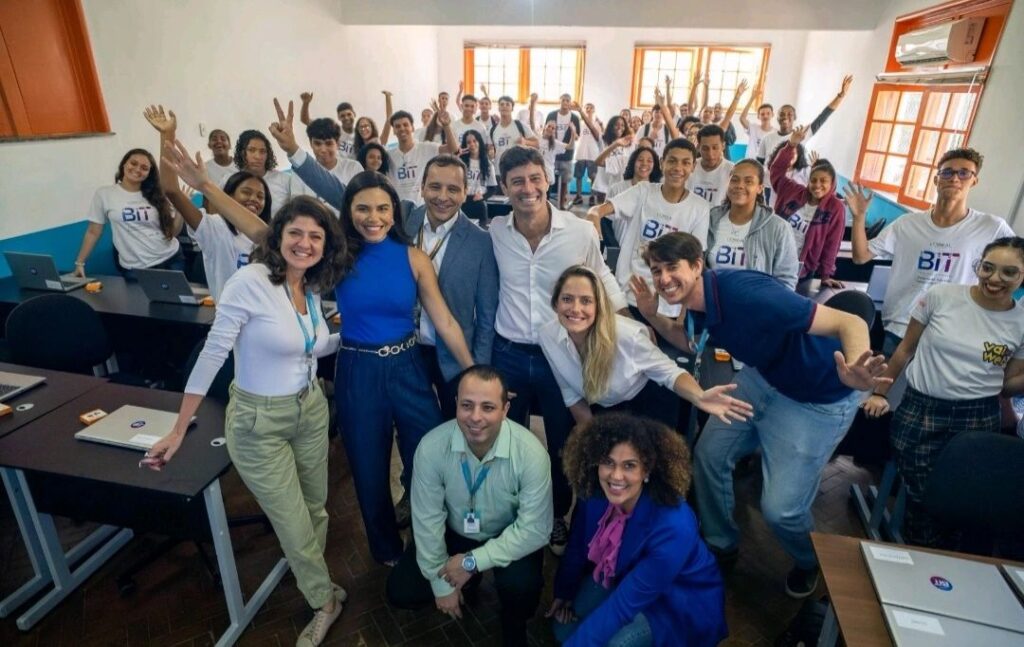
Em parceria com a L’Oréal, o Instituto Precisa Ser e o Vai na Web inauguramos no dia 03 de Julho o curso de capacitação em tecnologia! 50 jovens terão a chance de mergulhar no mundo digital para aprender linguagem, técnicas e fundamentos de programação, criando oportunidades profissionais para o futuro. O curso faz parte do Programa Bit – Beleza Inclusiva e Tecnológica, com o foco em construir uma sociedade mais responsável e inclusiva, trazendo conhecimentos, referências e novas perspectivas em áreas importantes do mercado, como é a tecnologia. Neste super encontro, ouvimos um pouco sobre a construção e importância do projeto por Marcelo Zimet, Presidente do Grupo L’Oréal no Brasil, William Potenti, Diretor de TI, e Heln Pedroso de Responsabilidade Social e Direitos Humanos. Além disso, Camila Crispim , Diretora da Fundação Darcy Vargas, também falou sobre a importância dessa parceria para o futuro dos estudantes da FDV.
Equipe FDV participa da formação introdutória ao Letramento Racial
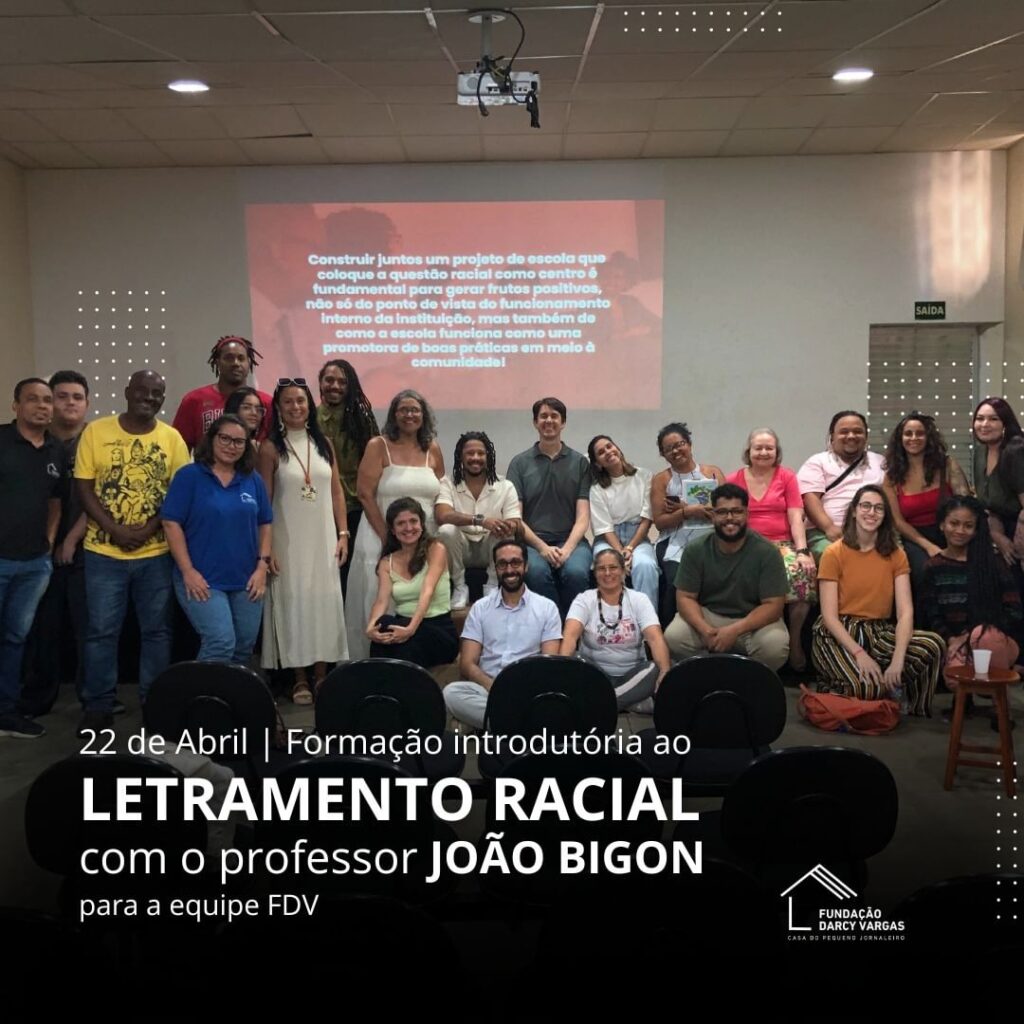
Na última segunda-feira, dia 22 de abril, a equipe FDV teve o prazer de ouvir o professor @ojoaob na formação introdutória ao Letramento Racial.Como estamos localizados no coração da Pequena África, é muito importante que todos os nossos colaboradores estejam alinhados quanto a temática da construção da cultura não apenas regional, mas que entendam a cultura que constrói, dita e mantém as ideias racistas. Essa foi uma oportunidade de apresentar a problemática a todos, para que estejam prontos para andar lado a lado à luta antirracista.O professor João Bigon chegou na FDV em 2024 para ministrar a disciplina de Produção Histórica e Cultural Afro-Brasileira, que tem o objetivo de criar vínculos entre o passado e o presente da história negra no Brasil e no mundo. Assim, os estudantes constrõem um pensamento local e global, entendendo as relações dos contextos históricos variados sobre a História da África e do povo negro com a realidade atual e as questões raciais.Para a FDV, é cada vez mais importante a construção do diálogo sobre questões sociais e raciais. Nossos projetos transbordam para o entorno, como o Belezas da Pequena África e o Saberes e Sabores, ambos em parceria com a @lorealgroupe_br , que são voltados para pessoas negras que se identificam com o gênero feminino. Esses projetos têm o foco em alavancar oportunidades no mercado de trabalho e abrir caminhos para o crescimento econômico das alunas.Juntos, podemos mudar o mundo! Muito obrigada a todos os colaboradores que compareceram e, claro, ao professor @ojoaob pela oportunidade de ouvi-lo!
FDV participa do Seminário O Rio do Futuro

No dia 09 de maio, nossa conselheira Camila Crispim, participou do painel “Cidade da Inclusão: Um novo paradigma para superar a ‘cidade partida’.”, do Seminário O Rio do Futuro: “O Plano Diretor e a próxima década”.Mediado por Carolina Morand , o debate sobre o lugar da pessoa negra na capital carioca contou também com a presença da vereadora @monicacunhario , da secretária de Meio Ambiente, @tainadepaularj , do jornalista @renesilva e do ativista @pretozezeFoi uma experiência única de falar sobre o papel da escola e de projetos sociais para garantir um futuro com maiores e melhores oportunidades, deixando o racismo e a desigualdade social no passado.
FDV realiza evento para convidados na Escola que Transborda
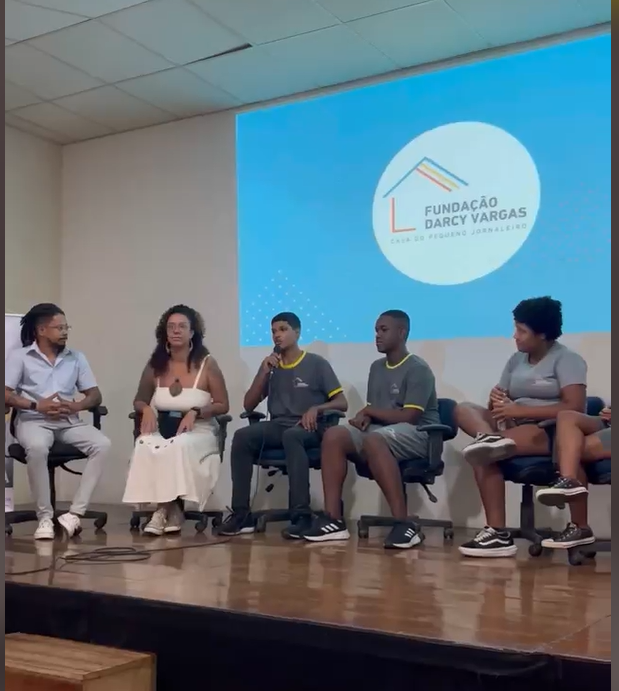
Começamos a semana com tudo! Na segunda-feira, 13 de maio, recebemos convidados, em sua maioria da área jurídica, para um almoço especial aqui na FDV. As atividades tiveram início com uma fala da nossa diretora Alice Franco e da conselheira Camila Crispim,. Também assistimos a um bate-papo mediado pelos professores João Marcos Bigon, Lorena Tato e Leonardo Cruz, trazendo o olhar dos alunos para o dia 13 de Maio, além de falar sobre as experiências dentro da escola e visões para o futuro. Depois, eles foram os protagonistas! Estamos acostumados a receber muitos visitantes aqui na Fundação, a falar do nosso trabalho e apresentar a escola. Mas, dessa vez, pensamos em um dos nosso pilares que norteiam o projeto pedagógico, que busca incentivar o protagonismo juvenil. Então por que não deixar que eles apresentem o espaço que ocupam todos os dias? Eles comandaram o tour com os visitantes, mostrando todo o ambiente e como aquele espaço realmente funciona e importa para eles. Agradecemos a todos que vieram e, claro, aos nosso estudantes que deram um show! Somos uma escola que transborda e estamos sempre de portas abertas! Entre em contato e venha conhecer a Fundação Darcy Vargas!
The Unfamiliar Planet: The Secrets Hidden Beneath Our Daily Reality
We live our entire lives on Earth, charting its surfaces, forecasting its weather, and relying on its predictable cycles of day and night. We have mapped its continents, named its mountains, and settled its shores. This constant exposure breeds a profound sense of familiarity, an illusion that our planet is a “known” quantity. But this understanding is razor-thin. Beneath the veneer of the everyday world, Planet Earth operates as a complex, alien, and astonishingly dynamic system, replete with biological marvels, bizarre geological forces, and cosmic connections that defy our intuition. The world we do not see is infinitely more vast and strange than the one we do. Perhaps the greatest testament to our ignorance is the ocean. We call this planet “Earth,” yet 71% of its surface is water. While modern technology has allowed us to map 100% of the surfaces of Mars and our own Moon to a high resolution, we have mapped less than 25% of Earth’s own ocean floor to a comparable level of detail. The vast majority of our planet—the entire deep ocean realm—exists in a state of perpetual, crushing darkness. The average depth of the ocean is a staggering 12,100 feet. At its deepest point, the Mariana Trench, the pressure exceeds 16,000 PSI, the equivalent of 100 elephants standing on a postage stamp. We long assumed such places were sterile voids, yet they are home to bizarre extremophiles, such as the snailfish and giant amoebas (xenophyophores) that have adapted to pressures that would instantly pulverize metal. The largest continuous features on Earth are also hidden here, including “underwater waterfalls” where cold, dense saltwater cascades off shelves into warmer abysses, creating cataracts far larger than any on land. While we are fixated on the Andes or the Himalayas, the largest and most significant mountain range on Earth is almost entirely invisible: the Mid-Ocean Ridge. This single volcanic chain stretches for 65,000 kilometers around the entire globe, like the seam on a baseball. It is here, at these spreading centers, that the planet continually builds new crust. While this ridge remains hidden, the engine driving it—the Earth’s core—holds perhaps the most startling thermal secret. We often think of the center of the Earth as molten, but the inner core is a solid sphere of iron-nickel alloy, and thanks to the immense pressure confining it, its temperature reaches nearly 6,000°C. Our planet’s solid core is as hot as the visible surface of the Sun. This extreme internal environment does not preclude life. One of the most revolutionary discoveries in modern science is the “Deep Biosphere.” Life does not stop at the soil; scientists have found a teeming biome of bacteria and archaea living miles deep within the Earth’s crust, cut off entirely from the sun, air, and everything we associate with surface ecosystems. These organisms “eat” rock, metabolizing minerals like sulfur and iron, and live on timescales of thousands of years. The sheer mass of this hidden life is staggering; estimates suggest this subterranean “dark life” may constitute more total biomass (by weight of carbon) than every plant, animal, and human on the surface combined. Our understanding of the surface biology we can see is also riddled with misconceptions. We are taught that the Amazon rainforest serves as the “lungs of the planet.” While rainforests are critically important for biodiversity, they are not our primary oxygen source. That title belongs to the ocean. It is estimated that 50% to 70% of the oxygen we breathe is produced by marine phytoplankton—microscopic, drifting plants that photosynthesize just like trees but on an infinitely larger and more distributed scale. Furthermore, our definition of the “largest” living thing is skewed toward animals. The blue whale is the largest animal, but it is dwarfed by the largest known organism. In Oregon’s Malheur National Forest, there is an “Armillaria ostoyae,” known colloquially as the Humongous Fungus. It covers nearly four square miles, is estimated to weigh tens of thousands of tons, and is believed to be several thousand years old. Most of this organism exists underground as a vast network of root-like filaments. This concept of a subterranean network has transformed our understanding of forests. Trees are not solitary individuals competing for resources; they are connected by a symbiotic network of fungi (mycorrhizal networks) dubbed the “Wood Wide Web.” Through this fungal Internet, “mother trees” can share nutrients and water with younger saplings, and even send chemical stress signals to neighboring trees to warn them of insect attacks. Finally, even our most fundamental experience—time—is not what it seems. A “day” is not 24 hours. The actual time it takes for the Earth to complete one full rotation (a sidereal day) is 23 hours, 56 minutes, and 4 seconds. Our 24-hour solar day is based on the Sun returning to the same spot in the sky, which takes longer due to our movement along our orbit. Furthermore, that rotation is slowing down. The gravitational pull of the Moon acts as a brake, creating tidal friction and causing the Earth’s spin to decelerate. When dinosaurs roamed, a day was closer to 23 hours. Millennia from now, a day will be significantly longer than 24. We are, in essence, inhabitants of a planet we barely know, all while hurtling through the galaxy at a speed of over 800,000 km/h. Earth is not a static backdrop to human history; it is an active, interconnected, and largely alien world, whose greatest secrets still lie waiting in the dark abyss and deep beneath our feet. Deneme Bonusu Veren Bahis Siteleri Deneme Bonusu Veren Bahis Siteleri Deneme Bonusu Veren Bahis Siteleri Deneme Bonusu Veren Bahis Siteleri Deneme Bonusu Veren Bahis Siteleri Deneme Bonusu Veren Bahis Siteleri Deneme Bonusu Veren Bahis Siteleri Deneme Bonusu Veren Bahis Siteleri Deneme Bonusu Veren Bahis Siteleri Deneme Bonusu Veren Bahis Siteleri Deneme Bonusu Veren Bahis Siteleri Deneme Bonusu Veren Bahis Siteleri Deneme Bonusu Veren Bahis Siteleri Deneme Bonusu Veren Bahis Siteleri Deneme Bonusu Veren Bahis Siteleri Deneme Bonusu Veren Bahis Siteleri Deneme Bonusu Veren
